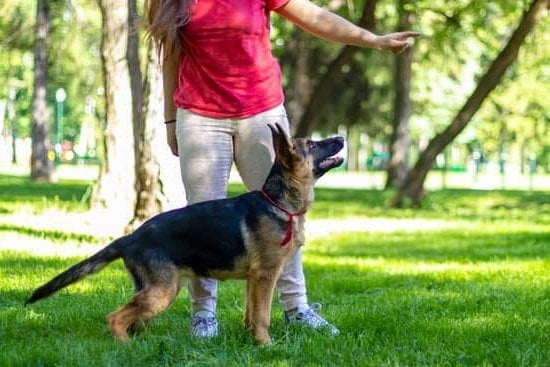Have you ever wondered how young can dog training begin? Training your furry friend from a young age is crucial for their development and behavior. In this article, we will explore the significance of early dog training and when is the right time to start. From puppy development and socialization to breed-specific considerations and effective training techniques, we will cover everything you need to know to set your puppy up for a lifetime of good behavior.
The ideal age to start training your dog is a topic that often sparks debates among pet owners and professionals. Puppy development and learning abilities play a significant role in determining when to commence training.
Early socialization is also crucial in introducing your dog to the world, while basic obedience training lays the foundation for good behavior. Additionally, different breeds may require tailored training approaches, and it’s essential to recognize signs of readiness in your puppy before beginning formal training.
As we dive into the importance of early dog training, we will discuss common mistakes to avoid as well as provide insights into recognizing signs that your puppy is ready for training. By understanding the significance of early training and learning techniques that align with your dog’s developmental stage, you can ensure that your furry companion grows into a well-behaved and delightful member of your family.
The Ideal Age to Start Training
When it comes to training a young dog, it’s essential to consider the ideal age to start. While some may believe that training should begin when a puppy is several months old, the truth is that the learning process can start as early as 7-8 weeks of age. At this stage, puppies are already beginning to learn from their environment and are capable of forming associations between actions and consequences.
It’s important to understand that while young puppies are capable of learning basic commands and behaviors, they also have limited attention spans and may tire easily. As such, training sessions should be kept short and fun, making sure not to overwhelm the young pup. Here are some key points to consider when determining the ideal age for starting your puppy’s training:
- Begin with simple commands: Start with basic commands such as “sit,” “stay,” and “come.” These commands lay the groundwork for future training and help establish a strong foundation for good behavior.
- Consider your puppy’s breed: Different breeds may mature at different rates, so it’s crucial to take into account your puppy’s specific needs and development timeline.
- Take cues from your puppy: Every puppy is unique, so pay attention to your pet’s individual readiness. Signs that they are ready for training include demonstrating focus during short sessions and showing an eagerness to please.
By taking these factors into account, you can determine the right time to begin training your puppy and set them up for a lifetime of good behavior.
Early Socialization
The early socialization of a puppy is a crucial part of their development and can have a lasting impact on their behavior as adult dogs. Early socialization involves exposing your puppy to a wide variety of people, animals, environments, and experiences in a positive and safe way. This helps them build confidence, learn to feel at ease in different situations, and develop good manners around people and other animals.
Experts generally agree that the critical period for socialization in puppies is between 3 weeks and 14 weeks of age. During this time, puppies are more open to new experiences and less likely to be fearful of unfamiliar stimuli. Introducing a young pup to different sounds, surfaces, objects, people, animals, and environments during this window of opportunity can help prevent fearfulness and aggression as they grow older.
It’s important to make these experiences positive by pairing them with treats, praise, toys or other rewards when your puppy reacts positively to new stimuli. However, it’s equally important not to overwhelm them. Exposing your puppy gradually to new experiences will allow them time to acclimate without becoming frightened or overwhelmed by the new surroundings or interactions.
| Aspect | Details |
|---|---|
| Critical Period for Socialization | Between 3 weeks and 14 weeks of age |
| How to Make Experiences Positive | Pairing them with treats, praise or rewards when your puppy reacts positively |
Basic Obedience Training for Puppies
Puppies are like sponges, soaking up information and learning from their environment at a rapid pace. This is why it is crucial to start basic obedience training at a young age.
Basic obedience training lays the foundation for good behavior and teaches essential skills that will benefit your dog throughout its life. The ideal time to start this type of training is when a puppy is around 7-8 weeks old, as this is when they start to form associations and understand cause and effect.
One of the most important aspects of basic obedience training for puppies is teaching them commands such as sit, stay, come, and down. These commands not only establish control over your dog but also help create a strong bond between you and your furry friend. It’s important to keep in mind that puppies have short attention spans, so training sessions should be kept short and fun to hold their interest.
Positive reinforcement is key when it comes to basic obedience training for puppies. This means using rewards such as treats, praise, or playtime to encourage good behavior. Consistency is also crucial – reinforcing the same commands in the same way every time will help your puppy understand what is expected of them. As with any type of training, patience and understanding are important factors in successfully teaching basic obedience skills to young dogs.
| Aspect of Training | Details |
|---|---|
| Ideal Age to Start | Around 7-8 weeks old |
| Key Commands | Sit, stay, come, down |
| Training Method | Positive reinforcement and consistency |
Special Considerations for Different Breeds
When it comes to training young dogs, it’s important to understand that different breeds have different needs and tendencies. Tailoring your training approach based on your dog’s breed can make a significant impact on the success of the training process.
Here are some special considerations for different breeds when it comes to training:
– Herding Breeds: Breeds such as Border Collies and Australian Shepherds are known for their herding instincts. They may exhibit behaviors such as nipping or chasing, which can be channeled into positive activities through proper training and mental stimulation.
– Hound Breeds: Hounds like Beagles and Bloodhounds have a strong sense of smell and may easily get distracted during training sessions. It’s important to use high-value treats and keep training sessions short and engaging to maintain their focus.
– Working Breeds: Breeds like German Shepherds and Rottweilers thrive on having a job to do. Training should include tasks or commands that challenge their intelligence and give them a sense of purpose.
Understanding the unique characteristics of your dog’s breed can help you customize your training approach to best suit their needs. Whether it’s providing mental stimulation, accommodating their natural instincts, or adapting to their learning style, tailoring your training will set the foundation for a well-behaved and well-adjusted adult dog.
Training Techniques for Young Dogs
Positive reinforcement and reward-based training are highly effective techniques for young dogs. These methods focus on encouraging good behavior by offering rewards and praise, rather than punishing or scolding the dog for undesirable actions. Positive reinforcement can include treats, toys, or verbal approval, while reward-based training involves giving the dog something they enjoy as a result of their good behavior.
One key aspect of these training techniques is consistency. It’s important to reward the desired behavior every time it occurs, at least in the initial stages of training. This helps the dog make a clear association between their actions and the positive outcome. Over time, the rewards can be gradually phased out once the behavior becomes more established.
Another important element of positive reinforcement and reward-based training is timing. The reward should be given immediately after the desired behavior occurs so that the dog can make a direct connection between their action and the consequence. In this way, they are more likely to repeat the behavior in the future.
In addition to treats and toys, positive reinforcement can also involve using verbal praise and affection as rewards for good behavior. Dogs are social animals and often respond well to human interaction, so offering enthusiastic praise or petting as a form of reward can be just as effective as edible treats. By building a strong bond with your dog through these positive interactions, you can further reinforce their good behavior and strengthen your relationship with them.
Signs That Your Puppy Is Ready for Training
Physical and Cognitive Development
Before starting any training, it’s important to consider your puppy’s physical and cognitive development. Puppies are typically ready to start training at around 8 weeks old when they have developed enough physically and mentally to be able to understand and respond to basic commands.
It’s important to note that every puppy is different, so it’s essential to observe your puppy’s behavior and consult with a veterinarian if you have any concerns about your puppy’s readiness for training.
Interest in Interacting With You
Another sign that your puppy is ready for training is their interest in interacting with you. If your puppy shows curiosity, responds positively to your voice, or follows you around, these are signs that they are open to learning from you. Puppies who seek out interaction with their owners are more likely to be engaged during training sessions and eager to learn new behaviors.
Ability to Focus and Concentrate
The ability to focus and concentrate is also an important indicator of a puppy’s readiness for training. Young puppies have short attention spans, so it’s crucial to start with short, positive training sessions.
If your puppy can maintain focus for a few minutes at a time and can follow simple commands like “sit” or “come,” they may be ready to begin basic obedience training. Remember that patience is key when working with young puppies as they are still developing their cognitive abilities.
Common Mistakes to Avoid When Training Young Dogs
Using Punishment-Based Training
One common mistake to avoid when training young dogs is using punishment-based training methods. While it may be tempting to reprimand your puppy for undesirable behaviors, this can actually be counterproductive. Punishment can cause fear and anxiety in your dog, leading to future behavioral issues. Instead, focus on positive reinforcement techniques to encourage good behavior and discourage bad habits.
Skipping Basic Obedience Training
Another pitfall to watch out for is skipping basic obedience training. It’s important to establish a foundation of good behavior early on, so your puppy understands the rules of the household. Skipping basic obedience training can result in a lack of control over your dog’s actions and behaviors. Consistency is key when it comes to teaching young dogs, so don’t neglect this essential aspect of their development.
Not Being Patient and Persistent
Training a young dog takes time, patience, and persistence. One mistake to avoid is expecting quick results or giving up too soon. Dogs, especially puppies, have short attention spans and may not grasp commands immediately. It’s important to be patient with them and continue practicing consistent training techniques. Persistence will pay off in the long run as your dog learns and grows into a well-behaved adult companion.
By being aware of these common mistakes and taking proactive steps to avoid them, you can set your young dog up for success in their training journey. Remember that every dog is unique, so it’s important to tailor your approach based on their individual needs and personality. With dedication and the right training strategies, you can help your puppy develop into a well-behaved and obedient member of the family.
Conclusion
In conclusion, setting your puppy up for a lifetime of good behavior starts with early training and socialization. The ideal age to start training is during the puppy stage when their learning ability is at its peak.
Early socialization is crucial for introducing your dog to the world and helping them develop into well-adjusted adults. Basic obedience training sets a foundation for good behavior, while tailoring the training to your dog’s specific breed considerations ensures that their needs are met.
Positive reinforcement and reward-based training techniques are highly effective for young dogs, helping them learn in a way that is both enjoyable and encouraging. It’s important to pay attention to signs that your puppy is ready for training and avoid common mistakes that may hinder their progress. By being patient, consistent, and understanding of your puppy’s individual needs, you can set them up for a lifetime of good behavior and strengthen the bond between you.
Remember that every dog is unique, so it’s essential to tailor their training to fit their personality and breed characteristics. By investing time and effort in the early stages of your puppy’s development, you can ensure that they grow into well-behaved, happy pets who bring joy to both you and those around them. Setting a strong foundation through early training will lead to a harmonious relationship between you and your furry companion for years to come.
Frequently Asked Questions
What Is the Youngest You Can Train a Puppy?
The youngest age at which you can start training a puppy is around 7-8 weeks old. Puppies at this age are able to start learning basic commands and behaviors, as they are beginning to develop their cognitive abilities and social skills.
What’s the Best Age to Start Training a Dog?
The best age to start training a dog is generally around 8-16 weeks old. This is the critical period for socialization and learning, so starting training during this time can help establish good behavior habits early on.
How Old Can a Dog Be Before It Can Be Trained?
Dogs of any age can be trained, but older dogs may require a different approach and more patience. While young puppies are like sponges when it comes to learning new things, older dogs may already have established behaviors that need to be unlearned or modified through positive reinforcement training techniques.

Welcome to the blog! I am a professional dog trainer and have been working with dogs for many years. In this blog, I will be discussing various topics related to dog training, including tips, tricks, and advice. I hope you find this information helpful and informative. Thanks for reading!





